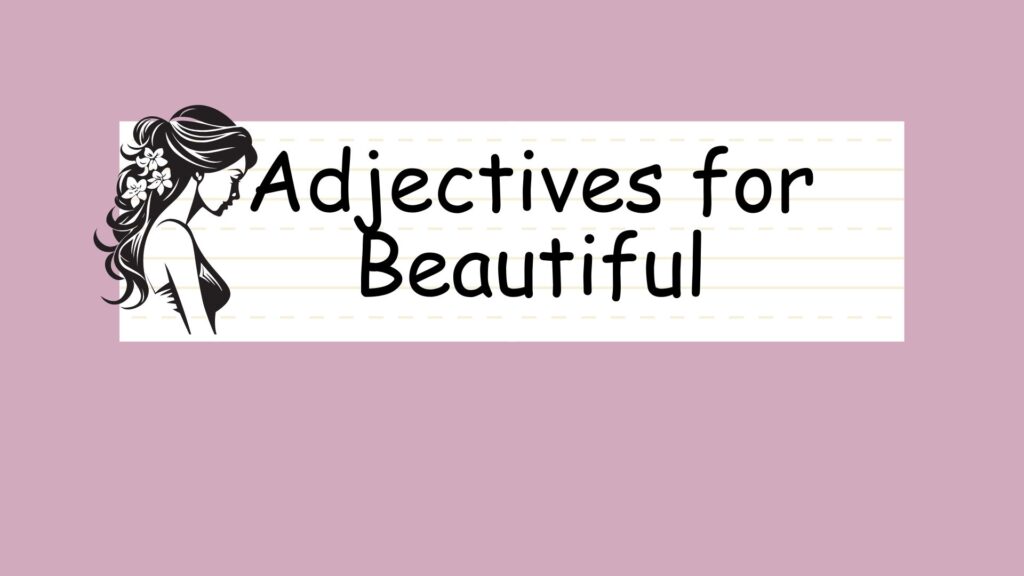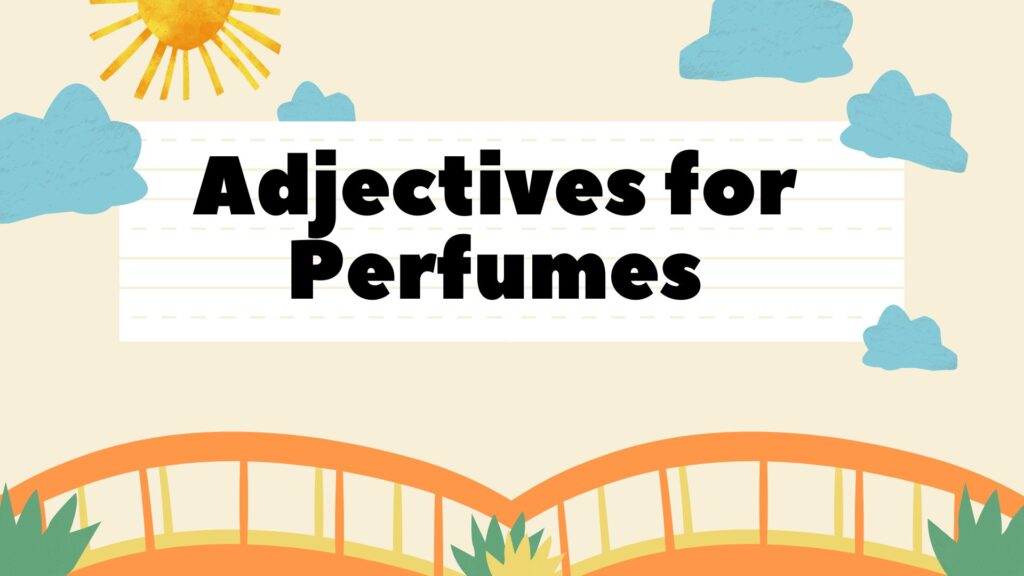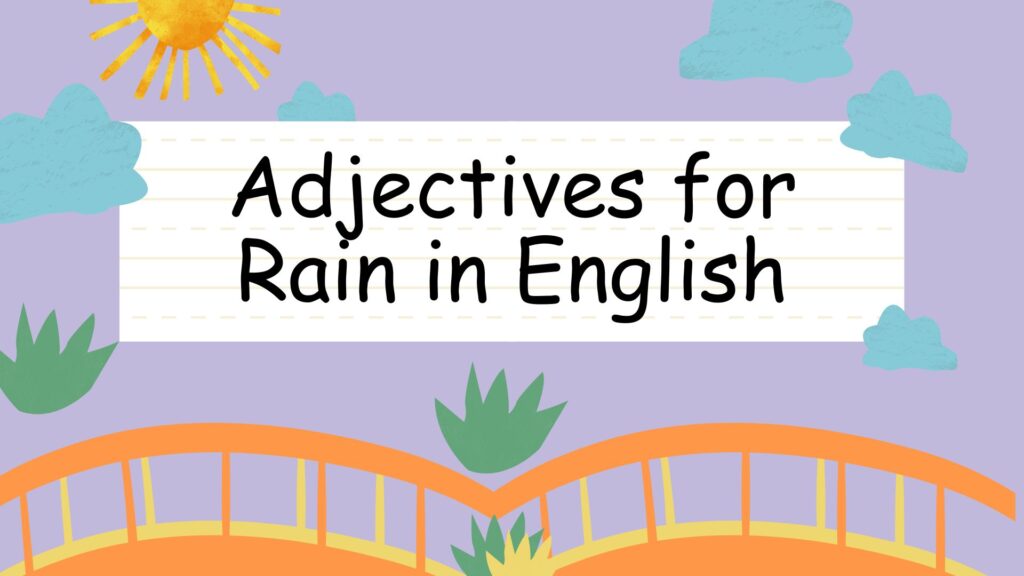The English language is rich with adjectives, and knowing how to describe beauty in its myriad forms is essential for effective communication. Whether you’re writing poetry, crafting compelling prose, or simply expressing your admiration, having a wide range of adjectives at your disposal can significantly enhance your descriptive abilities. This article provides a comprehensive exploration of adjectives used to describe beauty, covering various categories, usage rules, and common mistakes. It is designed for English language learners of all levels who wish to expand their vocabulary and improve their descriptive writing skills. From basic adjectives like “pretty” and “lovely” to more nuanced terms like “ethereal” and “radiant,” this guide will equip you with the tools to articulate beauty with precision and flair.
Table of Contents
- Introduction
- Definition of Adjectives for Beautiful
- Structural Breakdown
- Types and Categories of Adjectives for Beautiful
- Examples of Adjectives for Beautiful
- Usage Rules for Adjectives for Beautiful
- Common Mistakes When Using Adjectives for Beautiful
- Practice Exercises
- Advanced Topics
- Frequently Asked Questions
- Conclusion
Definition of Adjectives for Beautiful
Adjectives for “beautiful” are words used to describe something or someone possessing qualities of beauty, attractiveness, or aesthetic appeal. These adjectives go beyond simple physical appearance and can encompass inner beauty, moral excellence, artistic merit, and the sublime qualities found in nature. They function as modifiers, enriching nouns and providing more detailed and evocative descriptions. The specific adjective chosen often depends on the context and the particular aspect of beauty one wishes to highlight.
These adjectives are crucial for effective communication because they allow us to express nuanced opinions and feelings about the world around us. For example, describing a sunset as “beautiful” is accurate, but using adjectives like “breathtaking,” “majestic,” or “serene” conveys a much richer and more specific impression. Understanding the subtle differences between these words enables us to communicate more precisely and persuasively.
Structural Breakdown
Adjectives for beautiful, like all adjectives, typically precede the noun they modify (attributive position) or follow a linking verb such as “is,” “are,” “was,” “were,” “seems,” or “appears” (predicative position). Understanding this structural placement is crucial for correct sentence construction.
Attributive Position: In the attributive position, the adjective directly precedes the noun. This is the most common placement for adjectives in English.
Example: “She is a gorgeous woman.” (Gorgeous modifies woman)
Predicative Position: In the predicative position, the adjective follows a linking verb and describes the subject of the sentence.
Example: “The sunset was stunning.” (Stunning describes sunset)
Some adjectives can only be used in the attributive position (e.g., utter, sheer), while others can only be used in the predicative position (e.g., afraid, content). However, most adjectives for beautiful can be used in either position, providing flexibility in sentence structure.
Types and Categories of Adjectives for Beautiful
Adjectives for describing beauty can be categorized based on the aspect of beauty they emphasize. Here are some key categories:
Describing Physical Appearance
These adjectives focus on outward beauty, often related to attractiveness and pleasing aesthetics. They can describe features, figures, or overall appearances.
Describing Character and Personality
These adjectives describe inner beauty, focusing on positive qualities such as kindness, grace, and integrity. They reflect a person’s admirable traits and virtues.
Describing Nature and Scenery
These adjectives capture the beauty of the natural world, from landscapes and sunsets to flora and fauna. They often evoke feelings of awe, tranquility, and wonder.
Describing Art and Objects
These adjectives describe the aesthetic qualities of art, architecture, and other objects. They highlight elements such as craftsmanship, design, and artistic expression.
Describing Abstract Concepts
These adjectives describe the beauty found in abstract ideas, such as music, mathematics, or scientific theories. They often relate to harmony, elegance, and intellectual satisfaction.
Examples of Adjectives for Beautiful
This section provides extensive examples of adjectives for beautiful, organized by category. Each table includes a variety of adjectives with example sentences to illustrate their usage.
Table 1: Adjectives Describing Physical Appearance
The following table showcases adjectives that describe physical appearance, providing examples of how each can be used in a sentence to illustrate its meaning and context.
| Adjective | Example Sentence |
|---|---|
| Attractive | She is an attractive woman with a warm smile. |
| Gorgeous | The bride looked gorgeous in her white gown. |
| Lovely | He gave her a lovely bouquet of roses. |
| Pretty | The little girl had a pretty face with bright eyes. |
| Beautiful | The painting depicted a beautiful woman in a garden. |
| Stunning | The actress made a stunning entrance at the awards ceremony. |
| Exquisite | The jewelry was exquisite, crafted with delicate detail. |
| Elegant | She wore an elegant dress to the gala. |
| Radiant | The bride looked radiant on her wedding day. |
| Alluring | Her alluring eyes drew him in. |
| Charming | He had a charming personality that captivated everyone. |
| Cute | The puppy was incredibly cute and playful. |
| Dazzling | Her smile was absolutely dazzling. |
| Fine-looking | He was a fine-looking gentleman with impeccable manners. |
| Glamorous | She led a glamorous life filled with parties and travel. |
| Handsome | He was a handsome man with a strong jawline. |
| Ravishing | She looked ravishing in her red dress. |
| Striking | She had a striking resemblance to a famous actress. |
| Winsome | Her winsome smile made everyone feel at ease. |
| Comely | The comely milkmaid was the object of his affections. |
| Fair | The princess was known for her fair complexion. |
| Graceful | The dancer moved with graceful ease. |
| Statuesque | She possessed a statuesque beauty. |
| Well-favored | He was a well-favored young man. |
| Pulchritudinous | The poet described her as pulchritudinous. |
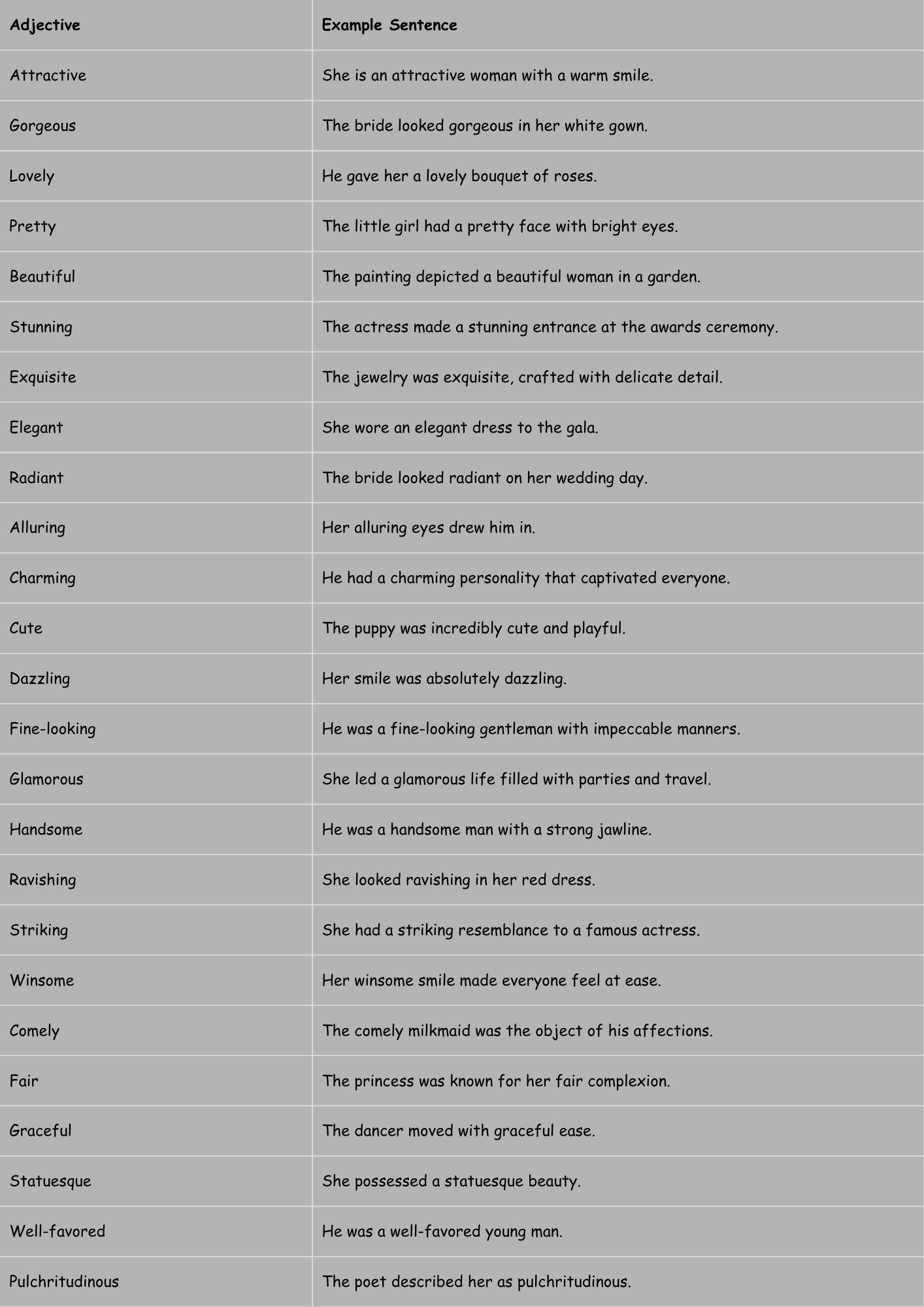
Table 2: Adjectives Describing Character and Personality
The following table showcases adjectives that describe character and personality, providing examples of how each can be used in a sentence to illustrate its meaning and context.
| Adjective | Example Sentence |
|---|---|
| Kind | She is a kind and compassionate person. |
| Generous | He is generous with his time and resources. |
| Compassionate | Her compassionate nature made her a great nurse. |
| Gracious | She was a gracious hostess, always making her guests feel welcome. |
| Good-hearted | He is a good-hearted man who always tries to help others. |
| Benevolent | The benevolent ruler cared deeply for his people. |
| Noble | He displayed noble qualities in the face of adversity. |
| Virtuous | She lived a virtuous life dedicated to helping others. |
| Chivalrous | He was a chivalrous gentleman, always respectful and courteous. |
| Dignified | She carried herself with a dignified air. |
| Honorable | He was an honorable man, true to his word. |
| Principle | She is a very principled woman. |
| Altruistic | Her altruistic actions benefited the entire community. |
| Selfless | His selfless dedication to the cause inspired many. |
| Moral | He is a man of high moral standards. |
| Upright | She is an upright citizen, respected by all. |
| Ethical | The company maintained ethical business practices. |
| Just | He was known as a just and fair judge. |
| Righteous | Her righteous anger was directed at injustice. |
| Resplendent | Her resplendent spirit shone brightly. |
| Aesthetic | Her aesthetic sensibility was evident in her decorating style. |
| Well-meaning | He is a well-meaning person, even if his actions sometimes backfire. |
| Philanthropic | Her philanthropic endeavors helped countless individuals. |
| Benevolent | A benevolent leader inspires loyalty and trust. |
| Magnanimous | He showed a magnanimous gesture of forgiveness. |
Table 3: Adjectives Describing Nature and Scenery
The following table showcases adjectives that describe nature and scenery, providing examples of how each can be used in a sentence to illustrate its meaning and context.
| Adjective | Example Sentence |
|---|---|
| Picturesque | The village was picturesque, nestled in a valley. |
| Scenic | The drive along the coast was incredibly scenic. |
| Majestic | The mountains stood majestic against the sky. |
| Breathtaking | The view from the summit was breathtaking. |
| Stunning | The sunset over the ocean was stunning. |
| Serene | The lake was serene and peaceful. |
| Tranquil | The garden provided a tranquil escape from the city. |
| Idyllic | They spent their honeymoon in an idyllic setting. |
| Sublime | The Grand Canyon is a place of sublime beauty. |
| Spectacular | The waterfall was a spectacular sight. |
| Enchanting | The forest was an enchanting place filled with mystery. |
| Lush | The rainforest was lush with vegetation. |
| Vibrant | The coral reef was vibrant with color. |
| Pristine | The beach was pristine and untouched. |
| Untamed | The wilderness was untamed and rugged. |
| Awesome | The Northern Lights were an awesome display of nature’s power. |
| Heavenly | The garden smelled heavenly after the rain. |
| Divine | The landscape had a divine beauty. |
| Ethereal | The mist gave the mountains an ethereal quality. |
| Pastoral | The pastoral scene evoked a sense of peace. |
| Arcadian | They dreamed of an Arcadian existence, far from the city. |
| Resplendent | The autumn forest was resplendent in color. |
| Verdant | The valley was verdant and fertile. |
| Edenic | They found an Edenic paradise on the remote island. |
| Resplendent | The resplendent sunrise painted the sky with vibrant colors. |
Table 4: Adjectives Describing Art and Objects
The following table showcases adjectives that describe art and objects, providing examples of how each can be used in a sentence to illustrate its meaning and context.
| Adjective | Example Sentence |
|---|---|
| Elegant | The design of the vase was elegant and refined. |
| Exquisite | The craftsmanship of the antique clock was exquisite. |
| Artistic | The sculpture was a truly artistic creation. |
| Masterful | The painting was a masterful display of skill. |
| Refined | The furniture was refined and sophisticated. |
| Impressive | The architecture of the cathedral was impressive. |
| Magnificent | The palace was a magnificent work of art. |
| Splendid | The tapestry was a splendid example of its kind. |
| Graceful | The lines of the building were graceful and flowing. |
| Ornate | The frame was ornate and heavily decorated. |
| Delicate | The porcelain doll was delicate and fragile. |
| Polished | The silver was polished to a gleaming shine. |
| Stylish | The furniture was stylish and modern. |
| Chic | The boutique displayed chic and fashionable items. |
| Classy | The restaurant had a classy and sophisticated atmosphere. |
| Creative | The artist had a creative and innovative approach. |
| Original | The artwork was original and unique. |
| Innovative | The design was innovative and groundbreaking. |
| Timeless | The design was timeless and classic. |
| Aesthetic | The aesthetic appeal of the design was undeniable. |
| Sublime | The music reached a sublime level of beauty. |
| Harmonious | The colors in the painting were harmonious and balanced. |
| Intricate | The detail in the carving was intricate and complex. |
| Luminous | The glass sculpture had a luminous quality. |
| Finely-wrought | The finely-wrought details of the clock made it a masterpiece. |
Table 5: Adjectives Describing Abstract Concepts
The following table showcases adjectives that describe abstract concepts, providing examples of how each can be used in a sentence to illustrate its meaning and context.
| Adjective | Example Sentence |
|---|---|
| Elegant | The mathematical proof was elegant and concise. |
| Harmonious | The music was harmonious and soothing. |
| Sublime | The philosophical concept was sublime and profound. |
| Profound | The poem had a profound message about life. |
| Inspiring | The speech was inspiring and motivational. |
| Moving | The story was moving and touching. |
| Poignant | The memory was poignant and bittersweet. |
| Ethereal | The music had an ethereal quality. |
| Luminous | Her spirit was luminous and radiant. |
| Divine | The inspiration felt divine and otherworldly. |
| Transcendent | The experience was transcendent and transformative. |
| Serene | The feeling was serene and peaceful. |
| Uplifting | The song was uplifting and cheerful. |
| Gratifying | The accomplishment was gratifying and rewarding. |
| Enlightening | The lecture was enlightening and informative. |
| Reassuring | Her words were reassuring and comforting. |
| Liberating | The truth was liberating and empowering. |
| Fulfilling | The work was fulfilling and meaningful. |
| Precious | The moment was precious and unforgettable. |
| Resplendent | His resplendent intellect shone through his writing. |
| Aesthetic | The aesthetic value of the theory was debated. |
| Sublime | The sublime beauty of mathematics captivated her. |
| Ineffable | The feeling was ineffable, beyond words. |
| Unutterable | The joy was unutterable and overwhelming. |
| Refulgent | The refulgent truth illuminated the path forward. |
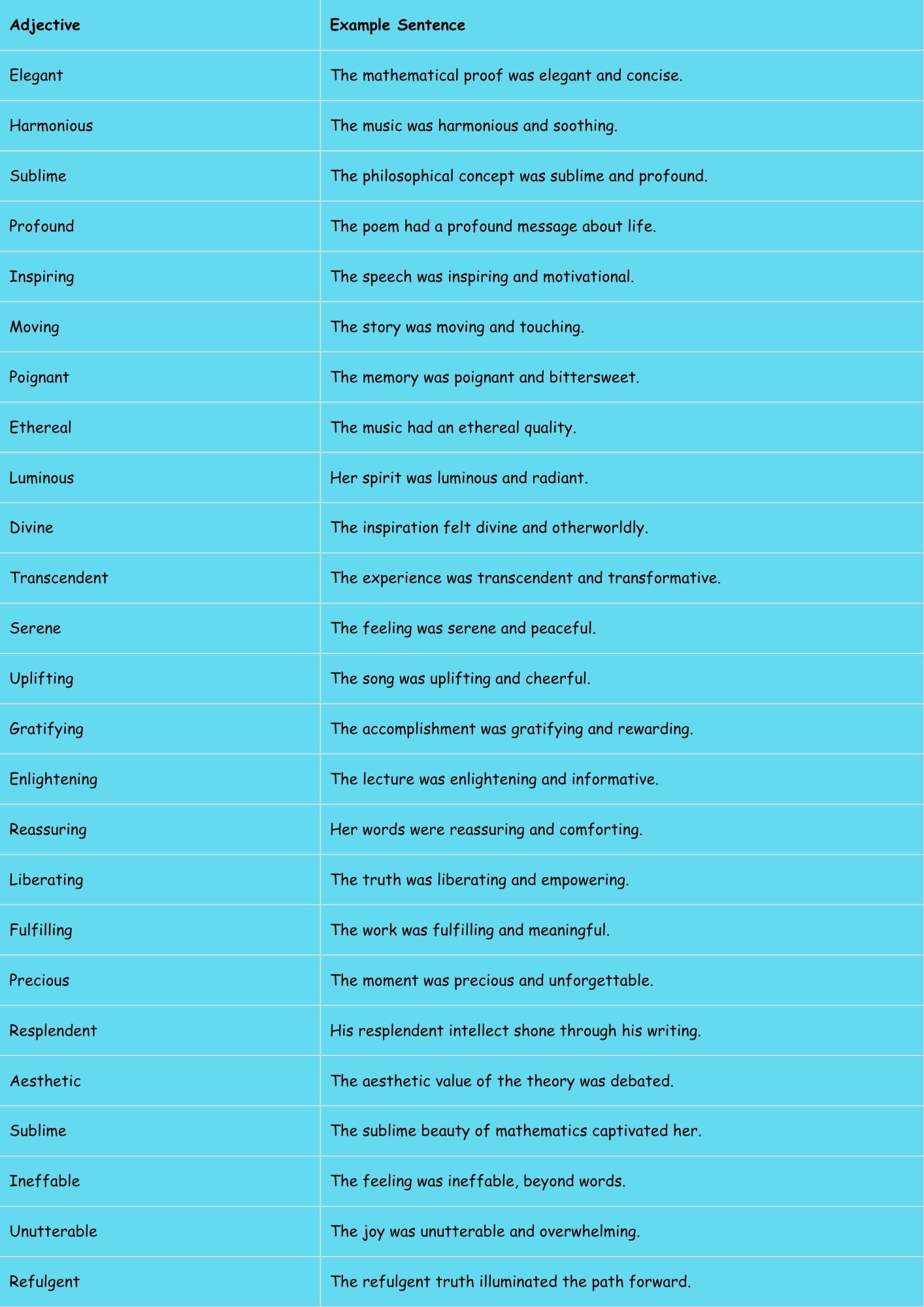
Usage Rules for Adjectives for Beautiful
Using adjectives for beautiful correctly involves understanding certain grammatical rules and nuances. Here are some key considerations:
- Adjective Order: When using multiple adjectives, follow the general order: opinion, size, age, shape, color, origin, material, purpose. For example: “a beautiful large old round blue table.”
- Comparative and Superlative Forms: Most adjectives form comparatives by adding “-er” or using “more,” and superlatives by adding “-est” or using “most.” However, some adjectives, especially those of Latin or Greek origin, do not follow this rule.
- Example: “pretty” – “prettier” – “prettiest”; “beautiful” – “more beautiful” – “most beautiful.”
- Coordinate Adjectives: When two or more adjectives equally modify a noun, separate them with a comma. For example: “a beautiful, elegant dress.”
- Cumulative Adjectives: When adjectives build upon each other to modify a noun, do not use a comma. For example: “a beautiful antique silver locket.”
Exceptions and Special Cases:
- Some adjectives have irregular comparative and superlative forms (e.g., “good” – “better” – “best”).
- Certain adjectives are considered non-gradable, meaning they cannot be used in comparative or superlative forms (e.g., “unique,” “perfect”). While some people might say “more unique,” it is technically incorrect.
Common Mistakes When Using Adjectives for Beautiful
Learners often make common mistakes when using adjectives for beautiful. Here are some examples with corrections:
| Incorrect | Correct | Explanation |
|---|---|---|
| She is more prettier than her sister. | She is prettier than her sister. | Use either “-er” or “more,” not both. |
| This is the most unique painting I’ve ever seen. | This is a very unique painting I’ve ever seen. | “Unique” is an absolute adjective and doesn’t take comparative or superlative forms. |
| A beautiful, old, red car. | A beautiful old red car. | Omit the comma between cumulative adjectives. |
| The sunset was beautifuler than yesterday’s. | The sunset was more beautiful than yesterday’s. | “Beautiful” requires “more” for the comparative form. |
| He is a kind, generous, man. | He is a kind, generous man. | Omit the comma before the noun. |
| The scenery was very much breathtaking. | The scenery was breathtaking. | “Breathtaking” is already a strong adjective; avoid unnecessary intensifiers. |
| She seems beautifully. | She seems beautiful. | Use an adjective after a linking verb like “seems.” |
| He is most handsomest man in the world. | He is the most handsome man in the world. | Use either “-est” or “most,” not both. |
| A stunning, absolutely view. | An absolutely stunning view. | Adverbs like “absolutely” should directly precede the adjective they modify. |
| The garden was serenely. | The garden was serene. | Use an adjective after a linking verb like “was.” |
Practice Exercises
Test your understanding with these practice exercises. Choose the best adjective to complete each sentence.
Exercise 1: Fill in the Blanks
Choose the best adjective from the list to complete each sentence: (gorgeous, kind, majestic, exquisite, serene)
| Question | Answer |
|---|---|
| 1. The mountains stood ________ against the clear blue sky. | majestic |
| 2. She wore an ________ necklace to the gala. | exquisite |
| 3. The lake was ________ and peaceful in the early morning. | serene |
| 4. The bride looked ________ in her white dress. | gorgeous |
| 5. He is a ________ and compassionate person, always willing to help. | kind |
| 6. The painting was an ________ masterpiece. | exquisite |
| 7. The ________ lion surveyed his domain. | majestic |
| 8. She offered a ________ smile to the stranger. | kind |
| 9. The garden was a ________ escape from the city. | serene |
| 10. They had a ________ view from their hotel. | gorgeous |
Exercise 2: Correct the Mistakes
Identify and correct the mistakes in the following sentences.
| Question | Answer |
|---|---|
| 1. She is more prettier than her friend. | She is prettier than her friend. |
| 2. This is the most unique sculpture. | This is a very unique sculpture. |
| 3. The sunset was beautifuler than ever. | The sunset was more beautiful than ever. |
| 4. He is a kind, generous, man. | He is a kind, generous man. |
| 5. The scenery was very much breathtaking. | The scenery was breathtaking. |
| 6. She seems beautifully. | She seems beautiful. |
| 7. He is most handsomest man in the world. | He is the most handsome man in the world. |
| 8. A stunning, absolutely view. | An absolutely stunning view. |
| 9. The garden was serenely. | The garden was serene. |
| 10. They had a picturesque, old, house. | They had a picturesque old house. |
Exercise 3: Sentence Completion
Complete the sentences with an appropriate adjective for beautiful.
| Question | Answer |
|---|---|
| 1. The dancer’s movements were ________. | graceful |
| 2. The landscape was truly ________. | breathtaking |
| 3. She had a ________ smile that lit up the room. | radiant |
| 4. The old castle looked ________ in the moonlight. | majestic |
| 5. The garden was a ________ oasis in the desert. | tranquil |
| 6. The music was ________ and calming. | harmonious |
| 7. His ________ behavior earned him the respect of everyone. | honorable |
| 8. The ________ details of the artwork were captivating. | intricate |
| 9. The island was an ________ paradise. | idyllic |
| 10. Her dress was ________ and stylish. | elegant |
Advanced Topics
For advanced learners, exploring the nuances of figurative language and literary devices can further enhance their ability to describe beauty. Techniques such as metaphors, similes, and personification can add depth and complexity to descriptions.
Figurative Language: Using metaphors and similes can create vivid and imaginative descriptions.
Example: “Her beauty was like a summer’s day” (simile); “The sunset was a painting in the sky” (metaphor).
Personification: Giving human qualities to inanimate objects or abstract concepts can make descriptions more engaging.
Example: “The mountains stood tall, guarding the valley below.”
Allusion: Referencing well-known works of art, literature, or mythology can add layers of meaning to descriptions.
Example: “She had a Mona Lisa smile.”
Frequently Asked Questions
- What is the difference between “beautiful” and “pretty”?“Beautiful” is a stronger term than “pretty” and implies a deeper, more profound aesthetic appeal. “Pretty” often refers to a more delicate or charming kind of beauty, while “beautiful” can encompass a wider range of qualities, including grandeur, elegance, and inner beauty.
- Can “handsome” be used to describe women?While “handsome” is traditionally used to describe men, it can sometimes be used to describe a woman with strong, striking features or a commanding presence. However, it’s generally more common and accepted to use adjectives like “striking,” “stunning,” or “elegant” for women.
- How do I choose the right adjective to describe beauty?Consider the context and the specific aspect of beauty you want to emphasize. Think about the overall impression you want to create and choose an adjective that aligns with that impression. A thesaurus can be a helpful tool for finding synonyms and exploring different shades of meaning.
- Are there any adjectives for beauty that are universally understood?While perceptions of beauty can vary across cultures, some adjectives like “radiant,” “elegant,” and “serene” tend to evoke positive associations in most contexts. However, it’s always important to be mindful of cultural differences and potential interpretations.
- Is it possible to overuse adjectives for beauty?Yes, overuse of any type of adjective can weaken your writing. Strive for a balance between descriptive detail and conciseness. Choose adjectives carefully and avoid using too many in a single sentence or paragraph. Sometimes, strong verbs and vivid imagery can be more effective than relying solely on adjectives.
- What is the role of cultural context in understanding beauty?Cultural context profoundly shapes perceptions of beauty. Standards of physical attractiveness, ideals of inner beauty, and appreciation for natural beauty can vary significantly across different cultures. What is considered beautiful in one culture may not be in another. Understanding these cultural nuances is essential for effective and respectful communication.
- How can I improve my descriptive writing skills?Practice regularly, read widely, and pay attention to the descriptive language used by skilled writers. Experiment with different adjectives and figurative language techniques. Seek feedback from others and be open to constructive criticism. The more you practice, the more confident and skilled you will become in your descriptive writing.
- Are there any negative connotations associated with certain adjectives for beauty?Yes, some adjectives can carry negative connotations depending on the context. For example, “alluring” can sometimes imply a manipulative or deceptive quality. “Glamorous” might suggest superficiality or excess. It’s important to be aware of these potential connotations and choose your words carefully to avoid unintended implications.
Conclusion
Mastering adjectives for describing beauty is crucial for enhancing your communication skills and enriching your descriptive writing. By understanding the different categories, usage rules, and common mistakes, you can articulate beauty with greater precision and flair. Remember to consider the context, choose your words carefully, and practice regularly to refine your descriptive abilities. From the simplest compliments to the most profound artistic expressions, the ability to convey beauty effectively is a valuable asset
.
By continually expanding your vocabulary and honing your descriptive techniques, you can unlock new levels of expression and appreciation for the beauty that surrounds us. Whether you are describing a person, a place, or an idea, the right adjectives can transform your words into vivid and compelling portrayals that resonate with your audience. Embrace the challenge of finding the perfect words to capture the essence of beauty, and your writing will undoubtedly become more engaging, evocative, and memorable.

